|
home |
|
The Fossils Handled by Children
Fossils 1-5 are handled by selected children in the
Fossils and Bones option, as well as the
Rocks and Fossils option. Fossils 6-8 are handled by all
the children in the Fossils and Bones
option (click for larger versions). If time allows I have
a variety of other fascinating fossils children can see.
|
 |
1. Vertebra from a theropod dinosaur
(two legged predator). Morocco, Late Cretaceous, about 90 million years
old. About 5cm wide.
|
 |
2. Tooth of a Spinosaurus - the
largest land predator of all time. Morocco, Late Cretaceous, about 100 million years
old. Nine pieces were found and glued together. 9cm long.
|
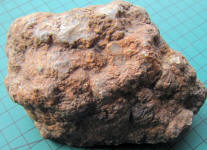 |
3. Dinosaur dung - a small piece of poo from an
Apatosaurus (aka Brontosaurus). Utah, USA. Late Jurassic, 160 million
years old. There's a chunk of this in a museum in Lyme Regis that weighs
73kg.
|
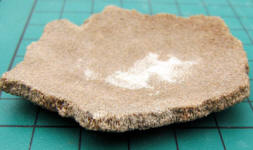 |
4. Piece of dinosaur eggshell -
possibly from a Saltasaurus (smaller relative of the Apatosaurus). From
Patagonia, Argentina. Late Cretaceous, 90 million years old. |
 |
5. Plesiosaurus rib section. Found - Jurassic.
Plesiosaurus was a long-necked sea reptile (not a dinosaur),
which looked
like 'Nessie'. |
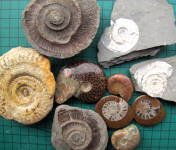 |
6.
Ammonites -
marine invertebrate with coiled shell, and a
squidlike creature inside. A very common fossil, found on the British
coastline and all around the world. Children will see a wide variety of
ammonites, all real.
|
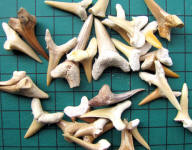 |
7. Shark teeth. Eocene, 55-45mya. |
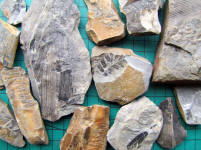 |
8. Plant fossils - various species, mainly ferns, tree
roots and
horsetail stems. Carboniferous, about 320 million years old. Found by me
at New Hey Quarry, Rochdale, Shaly Dingle near Bolton, and Poise Brook, Stockport. |
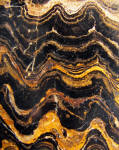
|
9. Stromatolite. Fossilised bacteria, forming layers,
from Bolivia. This is by far the oldest fossil in my collection, dating
to an unbelievable 2.2-2.4 billion years. For the first 3 billion years
of life on earth, no living thing had more than one cell.
|

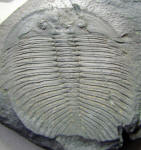 |
10. Trilobite eye: one of my most fascinating fossils,
collected from a stream near Ludlow, Shropshire, dating from the
Silurian (420 million years ago). Trilobites were amazingly successful
sea creatures, with 50,000 known species spanning 300 million years.
They were the first animals to have eyes that could see properly, using
compound structures similar to those of insects. However the lenses of
these eyes were made of calcite - transparent rock!
Left: Trilobite in the Manchester Museum. |

 |
11. Ichthyosaur vertebra: from Whitby, Yorkshire, about
190 million years old (Jurassic). Ichthyosaurs were sea reptiles
resembling dolphins. |
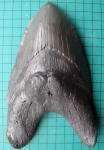

|
12. Megalodon tooth (copy): Megalodon carcharocles
lived from 28-1.5 million years ago. Its name means 'big tooth'. At up
to 18m in length, it is the largest predator of any type known. The
biggest Great White shark ever caught was 5.5m - one third the length of
Megalodon.
Left: the jaws of an enormous Megalodon. |














